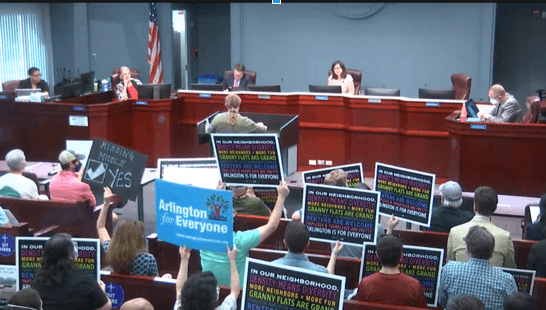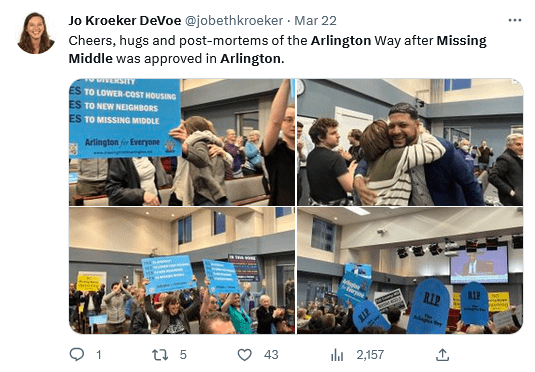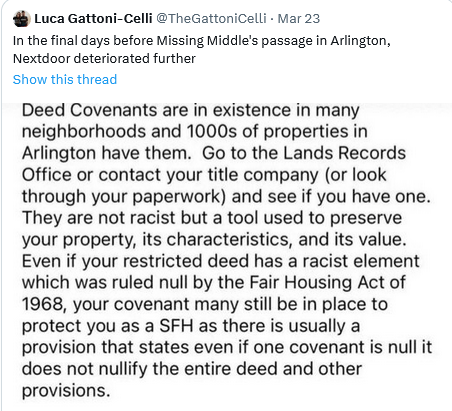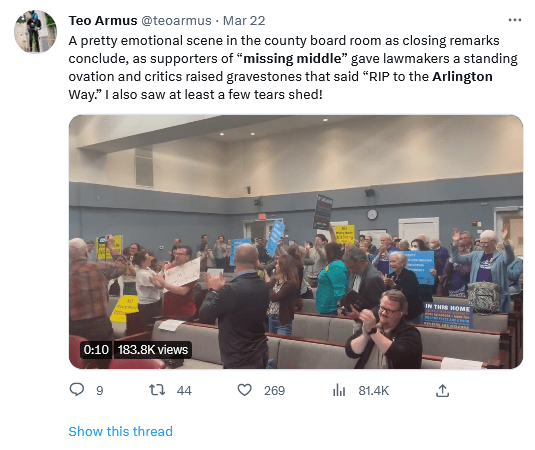Last month, the Arlington (VA) county board voted unanimously to approve allowing smaller structures like duplexes and cottage courts in neighborhoods that previously allowed only single-detached homes.
Arlington, like Chapel Hill, was seeing the redevelopment of older single-detached homes resulting in the construction of much larger and more expensive single-detached homes. The new zoning rules come with a temporary cap for units and neighborhoods.
At the meeting, one of the board members said “For our future to look like our past — where Arlington is shaped by Arlingtonians with public servants’ hearts and public servants’ salaries — we have to act.”
Many opponents to Arlington’s missing middle campaign used the same exact language and tactics we currently see in Chapel Hill.
A coalition of organizations worked together to support the proposal, including the NAACP Arlington Branch, the Sierra Club Potomac River Group, the interfaith group VOICE, the Northern Virginia Affordable Housing Alliance, the Arlington Partnership for Affordable Housing, Faith Alliance for Climate Solutions, Habitat for Humanity of Washington DC and Northern Virginia, the Arlington Chamber of Commerce, and YIMBYs of Northern Virginia.
We were impressed by their diverse perspectives and interests — and how well they worked together towards a common goal. We were also impressed by their organization and communication.
To learn more, we reached out to Luca Gattoni-Celli, the co-founder and chief executive of YIMBYs of Northern Virginia, and Jane Green, the President and co-founder of YIMBYs of Northern Virginia. They answered our questions over email.
TBB: We are thrilled for your success in Arlington. How did you stay positive in the face of so much social media vitriol?
Jane Green: I don’t use a lot of social media, except Twitter which is pretty friendly to YIMBYs. It is helpful to have a few pro-housing folks who have a thick enough skin to spend some time on NextDoor and Facebook, to show that pro-housing people exist.
Luca Gattoni-Celli: Intentionally, YIMBYs of NoVA’s only social media presence is the Facebook group we started out in, which we can tightly control. Individual team members took heat on Twitter, more so Jane than myself, but we brushed it off. I view people complaining about us on social media as proof we are being effective or at least viewed as a threat. Also free advertising. At least one person, maybe a few, said they sought us out after seeing how angry and unreasonable Missing Middle housing opponents were.
When opponents are nasty, let them be nasty. Let them do stupid things that make them less effective. Do not interrupt your opponent when they are making a mistake.
TBB: How did you encourage people to share stories when they might receive pushback (and are hesitant to speak publicly because of that)?
Jane Green: Educating people about the basics of the policy proposal made them feel comfortable giving public comment. We also used a “safety in numbers” approach, so we would have groups go together. And try to make any public speaking event fun by adding in a social gathering before or after. I ran virtual “info sessions” before major public hearings so people could learn about the policy as well as what to expect at the hearing.
Luca Gattoni-Celli: I am not sure it was a big factor, but we definitely heard directly and through the grapevine that some folks supported Missing Middle housing but felt too intimidated or worried about social cost to speak up. Once we had momentum there was a snowball effect, which I think helped a lot. Supporters decisively outnumbered opponents at almost all of the key hearings down the stretch. I always tell people their participation matters. We built something that felt like a winner, that people wanted to be a part of.
Would you change anything about your approach?
Jane Green: We should have spent less time worrying about the vocal opposition of NIMBYs who showed up at public meetings. I think the most influential people against our Missing Middle proposal were elder statesmen/women – previous elected officials and respected Democratic party leaders who were in opposition. Not NIMBYs, but a Smart Growth “old guard” who didn’t like wide-spread change. They like controlled planning. But they never spoke at a public meeting. They worked behind the scenes. Getting your local Democratic Committee on board, if you are in a Democrat-dominated environment like Arlington, would be very helpful.
Luca Gattoni-Celli: My big mistake was not focusing on email list growth from the beginning of our group. I had a baseless, ignorant belief that email is “annoying” but email makes the world go ‘round, in this context as in others. I agree with Jane that our biggest political and strategic weakness was Arlington Democratic party elders and former board members not being vocally supportive, with one or two exceptions at the end. They were not vocally anti, at least, but behind the scenes they were a detriment. I wonder if it led to a weaker final product, but we are very happy overall with what became law.
What advice would you have for other towns and cities who are working towards this?
Jane Green: From a policy perspective, do as much as you possibly can. There is no benefit from compromising with NIMBYs who will lie, hyperbolize, and misinform throughout the process.
From an advocacy perspective, gather the broadest set of allies you can. Be the most representative of the community. Have pro-housing voices at every public engagement opportunity.
Luca Gattoni-Celli: Be bold and go on offense. The burden of proof should be on the catastrophically failed status quo of expensive housing, long commutes, and homelessness. The debate should not just be about a proposed reform, which is almost certainly modest.
Opponents will be upset no matter what is proposed, whereas an ambitious policy provides something for supporters and allies to rally around. Missing Middle housing is the McGuffin that built up YIMBYs of NoVA. It forced us to mature as an organization and create all of the capabilities we needed, and drew lots of attention to our group.
What did you consider your bright lines (at which point the policy becomes toothless) and what were you willing to compromise on?
Luca Gattoni-Celli: I do not remember ever talking about this as a leadership team or thinking in these terms. Even on the shakiest days we felt confident we would end up with at least four units per lot. I am skeptical that we would have opposed any improvement over the status quo.
We did have to think about how to make decision makers work for YIMBY support. We did not want to be dismissed as automatic yes maximalists. In hindsight we could have figured out how to try to expand the Overton window’s upper bound.
What else would you like us to know? (What question do you wish we asked?)
Jane Green: Try not to spend time prognosticating about the hypotheticals that come up along the way, or about things that are outside of your control. Focus on what you have control over – how many people will show up at the public hearing; how many LTEs can you get published; how many people will sign your petition; etc.
Luca Gattoni-Celli: As Jane mentioned, we were able to build a community, within our group and with our allied organizations, that made housing advocacy social and fun. Our friends at VOICE reserved a conference room on the biggest day of public comment and filled it with positive energy, snacks, and a gratitude board. We held a prayer vigil in the hallway. That spirit made this a movement, something special people wanted to invest lots of time in. YIMBY has been such a blessing to me in so many ways, including the sense of community it has given me, and the sense of place I now have about where I live.
How did you create a coalition with other organizations?
Jane Green: The coalition came together because they understood that abundant housing helps everyone, and that ending exclusionary zoning is a moral imperative. It is important to keep people focused on the main goals, and not get hung up in debating stuff in the weeds.
Luca Gattoni-Celli: This could be a whole interview unto itself, so I will stick to the basics. YIMBYs of NoVA, the interfaith grassroots network VOICE, and NAACP Arlington Branch led the charge for Missing Middle housing, along with other allies such as leaders of the local Sierra Club, and Alliance for Housing Solutions, where Jane serves on the board. I was very persistent courting VOICE, which provided organizing expertise, moral authority, and huge numbers of Arlingtonians to testify. NAACP provided the moral authority only it could. Its leaders were vocal, unflinching supporters of Missing Middle housing and denouncers of historically racist, segregationist zoning. YIMBYs of NoVA was the connective tissue between the organizations and turned out its own members.
We have a lot of misinformation on neighborhood email listservs, which is hard to counter because we can’t see it. I’m curious how you got high-quality, good information out to people.
Jane Green: Our network of allies was large. We had the NAACP, a highly-coordinated consortium of religious congregations, a long-standing housing nonprofit with a robust list-serv, and our YIMBY Facebook group. We used this to share a common set of talking points that could appeal to people with different interests and backgrounds.
Luca Gattoni-Celli: Jane did an excellent job developing and circulating high-level talking points, hosting informational sessions, giving compelling media interviews, and on and on. One of our core values is civility and kindness, which includes not getting into back-and-forths with opponents. I think we were extremely disciplined about that. We focused on our message, our vision, and our reasons for supporting Missing Middle housing.
In Chapel Hill and Carrboro, there are a handful of people who are very active in local politics, while most people don’t participate (including college students, who make up more than a third of the town’s population). Do you have this issue in Arlington? How did you engage with activists, both in support of housing and opposed to it?
Luca Gattoni-Celli: “The Arlington Way” is the county’s traditional, highly participatory, consensus-driven civic engagement ethos. In practice it has come down to single-family homeowners getting their way, and even an official report from years ago cited by opponents noted that the process tends to exclude low-income people, parents of young children, and racial and ethnic minorities. On the day Missing Middle housing passed, opponents held up tombstone-shaped signs proclaiming “RIP The Arlington Way.” Hopefully they are correct. We out-organized our opponents. We executed our gameplan, articulated our vision, and stayed positive. I think it worked. Certainly I used Twitter to document truly toxic opponent behavior, but we were very focused on our own positive message.
Politics is an open field. There are rules and laws to follow, and a high ethical standard we hold each other to, but any individual can shape the political landscape. We activated dozens of people who were certainly not grassroots housing advocates a couple of years ago, when our group did not exist. Your voice is powerful, use it.
A key point to add, we did not engage directly with opponents, as a rule. A member of our team has friendly personal relationships with many, so he was able to have conversations that provided us useful context, but we really tried not to think about opponents any more than we had to. Better for them to spend more time thinking about us. Exceptions were major events like the Arlington Civic Federation creating a hackneyed resolution directly targeting us (which I took great pleasure in). I am also tickled that one opposition group devoted pages on their website to attacking us.
What’s next?
Luca Gattoni-Celli: So much! Breaking it down by locality:
Arlington County
- Arlington’s County Board has two open seats this year, being vacated by the two strongest housing supporters on the board, so securing two good replacements is extremely important. We have sent out candidate questionnaires for the Democratic primary, which will almost certainly pick the ultimate winners. We have 500 email subscribers in Arlington who we will activate as campaign volunteers and voters.
- Plan Langston Boulevard is an initiative to upzone and improve the street design of Arlington’s northern arterial road. It is a big opportunity to allow for more housing in the county. We have to be careful not to attract counterproductive attention, though the plan is more popular and much less controversial than Missing Middle housing, which was also by nature a countywide fight.
- We are tracking one or two strategically important development projects
Alexandria City
- Zoning for Housing, including its history-focused racial justice component Housing for All, is a major initiative that was relaunched this year, with the intention of reforming land use rules at the end of 2023. It encompasses ten or eleven elements from single-family zoning and reducing exclusionary practices to commercial to residential conversions and reassessing the usage of historic districts. I live in Alexandria and am excited to step onto the field more.
Fairfax County
- Fairfax contains more than two-thirds of Northern Virginia’s population, not including exurban counties, and is the most populous locality in the D.C. region. Densifying this massive, sprawling suburban county is the litmus test for the success of our organization and NoVA itself. We recently started making inroads in the county through project-specific advocacy, and are excited for the future.
Richmond City
- We are eager to support our friends at RVA YIMBY, a new chapter of our parent organization, YIMBY Action. A strong presence in the capital of our commonwealth will be necessary to build a network to support state-level preemption of local land use authority, which will clearly be necessary to enable new housing at sufficient scale to finally resolve Virginia’s affordability crisis.
Martin Johnson, Geoff Green, and Melody Kramer wrote the questions for this interview.




